 Justin Fox Burks
Justin Fox Burks
Graffiti symbolizing Latino gang “Playboy Sureños 13”
On the night of September 6th, a crowd of teenagers randomly targeted and beat three people in the Poplar Plaza Kroger parking lot. A portion of the assault was captured on a smartphone.
The phone video footage of the incident was uploaded online and quickly went viral. The video displays a group of teens, reportedly around 100 of them, running from a nearby CiCi’s Pizza to the grocery store parking lot. Some of them target a 25-year-old man by his car. Circling him, several people in the mob shower the man with punches to the head and face as he flees toward the store entrance.
The video then shows a 17-year-old Kroger clerk, one of two employees who rushes to help the first victim, being punched by two or three of the teens. He’s knocked to the ground and kicked repeatedly in the head. Large pumpkins are thrown at his head and face as he lies on the ground unconscious.
Nearly a dozen teenagers, ranging from 14 to 19 years old, have been arrested, thus far. They face charges varying from aggravated assault to aggravated rioting. Law enforcement has identified several of the juveniles as gang members.
Though the Kroger incident was not necessarily a gang-organized event, the gang culture is a real problem in Memphis. There are 9,100 documented gang members and 170 documented gangs and subsets in the area, according to the Tennessee Gang Investigators Association (TNGIA). This number does not take into account undocumented members, which authorities say could double that number.
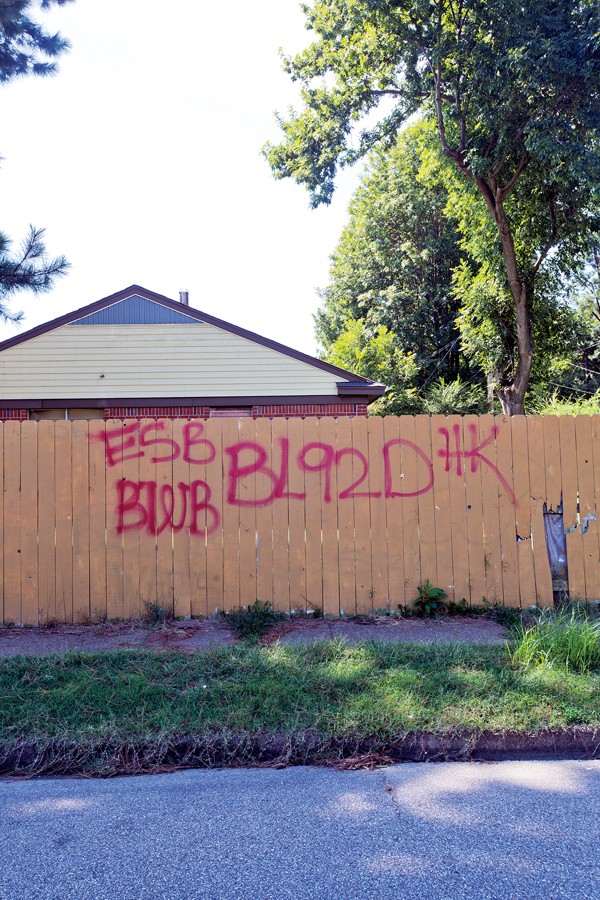 Justin Fox Burks
Justin Fox Burks
Graffiti of a Bloods subset in East Memphis
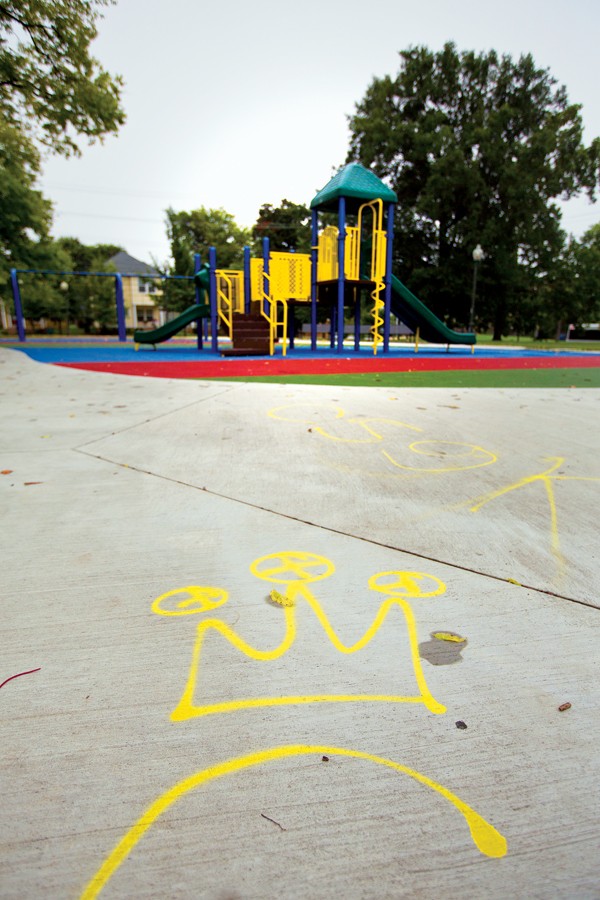 Justin Fox Burks
Justin Fox Burks
Graffiti downtown symbolizing the “Greenlaw Money Mob”
Finding a Way Out
Ar’tavius Brown, 18, hails from Westwood, a South Memphis neighborhood where some gang activity occurs. Intrigued by the lifestyle he had seen many of his peers embrace, Brown decided to join the gang culture.
“Seeing the people with the cars, with the money, you see how they get it quick, and you start to want it too,” says Brown.
In the seventh grade, Brown joined a Westwood faction of the Pirus, a gang founded in California. It falls within the Blood Gang Alliance. Members primarily dress in red clothing and bandanas to symbolize their association.
Before he joined in, Brown witnessed the impact of gang and criminal activity. Many of his family members are gang members. He has an uncle who’s serving life in prison for murder, and he witnessed a close friend get gunned down by rival gang members.
But it wasn’t until last fall that Brown personally experienced the ramifications that come with gang life. In October 2013, some Crips, a rival set to the Pirus, tried to jump him. A Central High School senior at the time, Brown pulled out a pistol and started firing shots at the group while chasing them. No one was hit, but Brown was apprehended for the shooting.
“I went to jail on two counts of aggravated assault and reckless endangerment with a deadly weapon,” Brown says. “They were talking about upgrading it to first-degree attempted murder, but [Juvenile Court] Judge Dan Michael saw something in me and gave me a break.”
Blessed with a second chance, Brown is no longer an active Piru member. He managed to graduate from high school, despite his incarceration, and he is now mentored by Young Man University, an organization dedicated to helping underprivileged youth and adult males avoid imprisonment and criminal lifestyles. College is next for him.
 Justin Fox Burks
Justin Fox Burks
“Love Mob” gathers at Poplar and Highland in response to Kroger parking lot beating.
A National Problem
But the problem isn’t just local. According to the FBI, in 2011, there were approximately 1.4 million active street, prison, and outlaw motorcycle gang members, comprising more than 33,000 gangs in the United States.
In 2012, Tennessee had 30,000 gang members (25,000 at large and 5,000 in prison), according to the Governor’s Public Safety Forum on Tennessee Gangs. For comparison’s sake, consider that there were only around 14,000 law enforcement officers in the state that year.
In Memphis, various gangs operate within different pockets of the community. Gang activity happens in rural areas, but it is most prevalent in predominantly black communities such as North Memphis, South Memphis, Frayser, Northhaven, Whitehaven, Binghampton, Orange Mound, and Hickory Hill.
Memphis’ Riverside community is primarily the territory of the Riverside Rollin’ 90’s Crips. The area has been plagued with violence and drug activity. Over a 10-month period, the Riverside Rollin’ 90’s were investigated by the Multi-Agency Gang Unit (MGU), a collective comprised of local, state, and federal law enforcement agencies that specifically targets gangs and gang members in Memphis. Throughout the investigation’s duration, there was at least one shooting per day, and 1,200 calls regarding gang-related matters were reportedly made to police.
“Memphis has a serious gang problem,” says Fred Winston, operations commander for MGU. “We target people who are really out there affecting where people live. We’re trying to get the worst of the worst off the street.”
Following MGU’s investigation, a gang injunction was issued on the Riverside Rollin’ 90’s in a 4.6-mile radius of Riverside. Bordered by South Parkway, West Mallory, I-55, and Florida Street, the targeted area is home to 4,000-plus residents. The injunction, which was implemented in September 2013, declared the gang a public nuisance and outlawed them from associating publicly, possessing firearms, distributing drugs, and a host of other things. Anyone violating the city ordinance can be arrested, charged with contempt of court, and fined.
“It’s made great strides in bringing some stability back to what many describe as a war-torn area,” says Shelby County District Attorney General Amy Weirich with regard to the gang injunction. “That area had just become the playground of the Rollin’ Riverside 90’s Crips.”
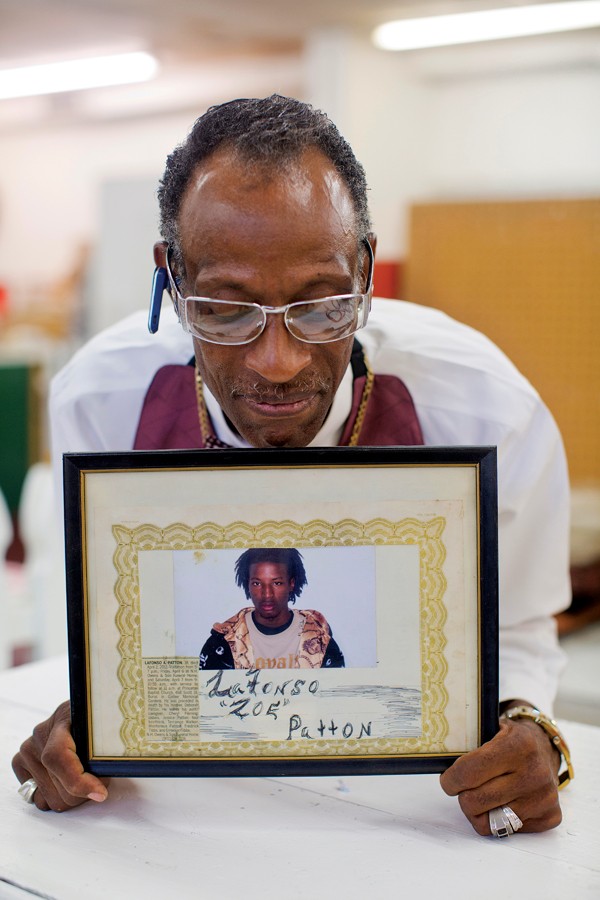 Justin Fox Burks
Justin Fox Burks
Fred Tibbs, father of slain 18-year-old Lafonso Patton
Victim by Association
Some people join gangs to feel accepted and appreciated, others because they’re looking for a way to make fast money. Whatever the motivation, after joining, the chances of that person being placed in a life-threatening situation or facing incarceration increases greatly.
And gang activity doesn’t just endanger the lives of gang members; it places those who associate with them and live around them in peril as well.
The last time Fred Tibbs saw his son Lafonso Patton alive was March 31, 2012. The 18-year-old East High School graduate left the house that night to go hang out with three friends in Orange Mound.
As always, Tibbs told him to “come home safe.” But Lafonso never returned home. Close to midnight, a frantic voice alerted Tibbs on the phone that his son had been shot.
“He was with a friend, and the friend had seen a female that he used to talk to. He said something to her and they got into a heated argument,” Tibbs recalls. “Some of the guys on the street heard it, and they started hollering at him. [Lafonso’s friend] hollered out, ‘I’m Piru. [Fuck] Orange Mound. We ain’t from the Mound, we from [Binghampton].’ And out of that crowd, somebody ran behind a house, got a gun, and started shooting at them.”
As he and his friends began running for their lives, Lafonso was the only one who failed to escape. Struck in the head, he was able to take a few more strides before collapsing. When Tibbs arrived at the scene, Lafonso was slumped over in a drain, lifeless at the corner of Deadrick Avenue and David Street.
“I went into shock,” Tibbs remembers. “I actually had to go get psychological help. I lost it.”
Tibbs says Lafonso wasn’t a gang member. He was scheduled to start his first day at Lit, a wholesale restaurant supply company, the day following his murder. Two years later, no arrest has been made in his homicide.
Gangs in Schools
Memphis is home to various Chicago- and California-based gangs: Crips and Bloods subsets, Gangster Disciples, Vice Lords, Latin Kings, Black P. Stones, Four Corner Hustlers, Mara Salvatrucha 13, Sureños 13, and numerous others. There are also Memphis-based gangs with notorious reputations, including Young Mob, Dixie Homes Murda Gang, Fam Mob, and Kingsgate Mafia.
Some boast a significant juvenile membership, which can lead to gang-related issues infiltrating local school systems.
The Gang Reduction Assistance for Saving Society’s Youth (GRASSY) Program provides resources to students affiliated with gangs, which helps make resisting street life more feasible for many. Since 2009, GRASSY has helped reduce gang expulsions in school by 63 percent, increased school attendance and graduation of gang members, and decreased office referrals.
“We’re not trying to necessarily get a kid out of a gang; we’re trying to get them resources to make them productive and proactive citizens and give them pro-social skills,” says Ron Pope, director of the GRASSY program. “Children have to want to get out of a gang. All of the programs are voluntary. They have to want to receive the services, and it’s up to them to determine what their activity level in the gang will be. Our goal is to convince them to be as inactive as possible.”
GRASSY provides all Shelby County Schools (SCS) students with the opportunity to work with a gang prevention specialist and receive intervention services. Two of its primary targets are Hamilton and Trezevant — high schools that possess a significant gang presence. A caseworker operates in both schools 40 hours per week, providing counseling, financial assistance, and other resources and services to identified gang members to help deter them from gang activity.
Other schools located in areas with gang problems can also access assistance from a part-time GRASSY caseworker.
KeAnna Mitchell, a 17-year-old Northwest Prep Academy student, says peer pressure from friends motivated her to join the Bloods. Since being initiated, Mitchell has lost several of her close friends to violence. And her boyfriend, a Gangster Disciple, was fatally shot in the head after trying to rob someone.
“Now that I’m in it, it hasn’t done anything for me,” Mitchell admits. “Before I made the decision, I was a normal kid. But after I joined the gang, I went to jail, [because] I had a pistol on me. It was peer pressure. I just wanted to be that hard person.”
Although she still considers herself a Blood, Mitchell is no longer active. She’s a graduate of Hope Academy, an educational program provided by Shelby County Juvenile Court to teens arrested for crimes ranging from misdemeanors to felonies. She has plans to attend college.
Organized Crime
The gang culture has become more organized over recent years. A lot of high-ranking gang members don’t look like a stereotypical hoodlum. Many run their criminal operations using business practices more common to legitimate enterprises.
Carter F. Smith, co-founder of TNGIA, has been researching gang culture for a quarter century. Throughout the years, he’s observed the transition in Tennessee’s gang climate. Smith says more gang members are infiltrating the military, law enforcement, and college campuses, making it more challenging for law enforcement to observe and combat gang activity.
“Most gang members don’t even get detected by the police,” Smith says. “They’re more organized-crime oriented, and they avoid detection because they’re not committing the typical street crimes that most people will report. The stereotypical gang member, if you ask any member of the public or most cops, has baggy pants, some color of choice, depending on the nation he’s representing, tattoos everywhere, and symbology from his gang on everything he owns. In reality, the typical gang member in advanced form blends into society. You can’t pick them out of a line-up unless they actually committed a crime.”
In July 2013, Tennessee Governor Bill Haslam signed into law a bill that enhances sentencing of any proven gang member who commits a crime identified as a “criminal gang offense.” If a prosecutor can prove that the perpetrator is a gang member, they can be punished one classification higher than the offense requires with charges such as first-degree murder, aggravated assault, kidnapping, robbery, and rape. And if the accused is an identified gang leader, they can be punished two classifications higher than the offense requires.
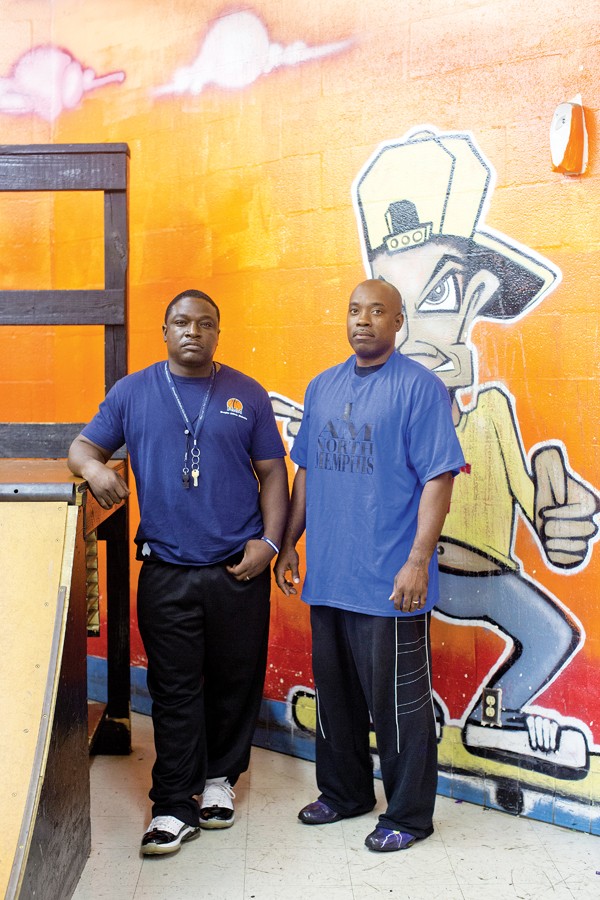 Justin Fox Burks
Justin Fox Burks
Dionysus Sisson with Detric Golden, director of Greenlaw Community Center
Changing Lives
Dionysus Sisson, 42, grew up in a South Side Chicago neighborhood dominated by Black P. Stones, a Chicago-based street gang that now operates around the world — including in Memphis.
At age 11, Sisson joined the Black P. Stones. By his teens, he had garnered a chilling reputation for being heartless and trigger-happy. He rose in rank, going from an officer to a general of the organization.
He has spent half of his life behind bars for numerous misdemeanor and felony offenses. His outlook on life changed during his most recent prison stint when he decided to cease gang-banging and embrace Christianity.
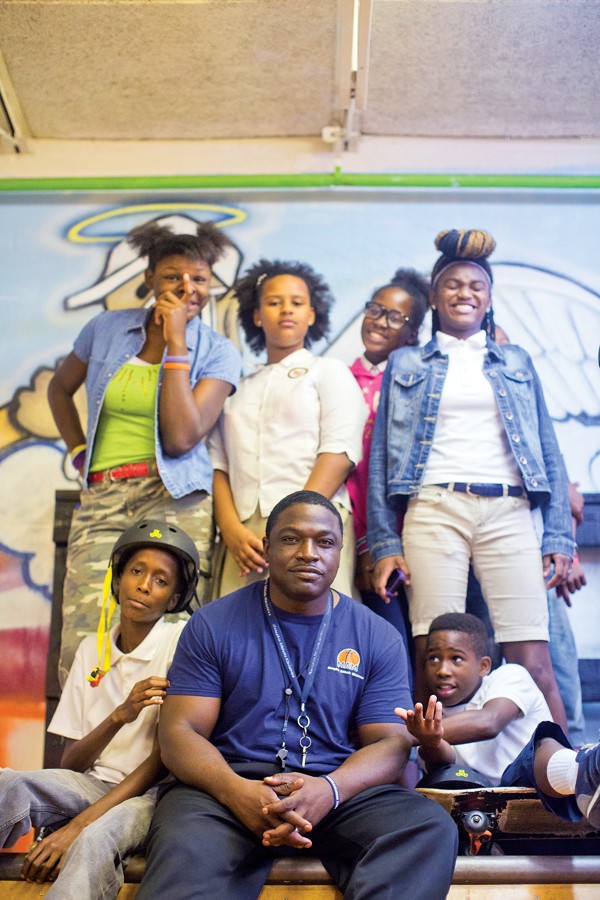 Justin Fox Burks
Justin Fox Burks
Youth Foundation with youth
After being released in 2011, Sisson began working with the Youth Foundation, an entity that collaborates with gang prevention agencies in Memphis to restore hope to disadvantaged youth. Along with Youth Foundation founder Thomas Norphlet, Sisson travels to different neighborhoods to mentor at-risk youth, provide training and employment resources, and inform them of the consequences that come with gang activity and gun violence.
“It’ll change you when you look into a dying man’s eyes, but it’s another type of change when you look into a boy’s eyes and he realizes that he can live,” Sisson says. “I’ve seen them both, but this is the one I wanted. I wanted to be able to open somebody’s eyes instead of closing them.”
Gang culture isn’t going away anytime soon, in Memphis or nationally. But those working to fight the problem believe a collective response from the community and local government and law enforcement can help. A united approach is needed to provide youth with assistance, mentorship, recreational outlets, and employment opportunities.
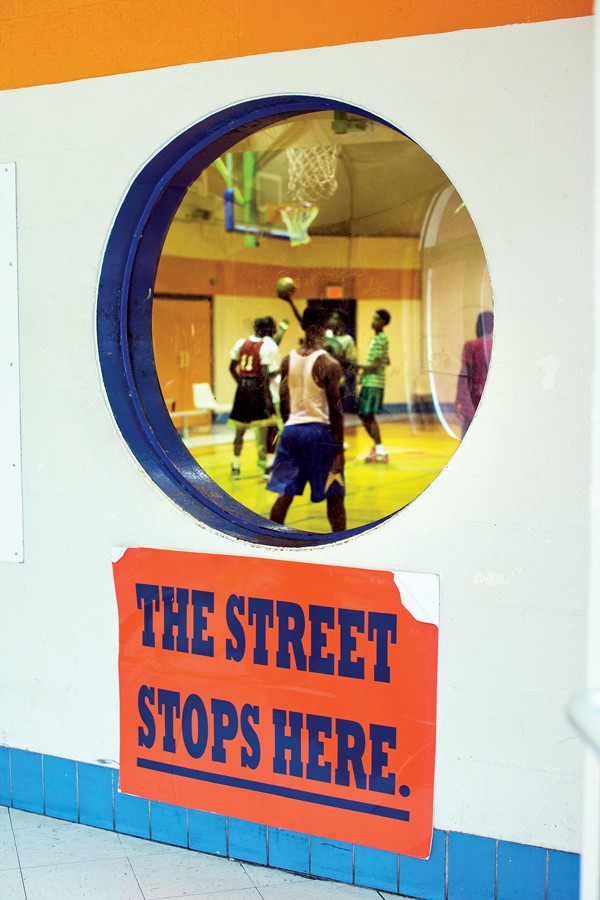 Justin Fox Burks
Justin Fox Burks
“They want a sense of belonging,” Sisson says with regard to disadvantaged youth. “They want to be loved. They want to be respected. And if we don’t give them that love at home or that respect in the community, they’re going to find it in somebody’s gang.”

 Justin Fox Burks
Justin Fox Burks  Justin Fox Burks
Justin Fox Burks  Justin Fox Burks
Justin Fox Burks  Justin Fox Burks
Justin Fox Burks  Justin Fox Burks
Justin Fox Burks  Justin Fox Burks
Justin Fox Burks  Justin Fox Burks
Justin Fox Burks  Justin Fox Burks
Justin Fox Burks